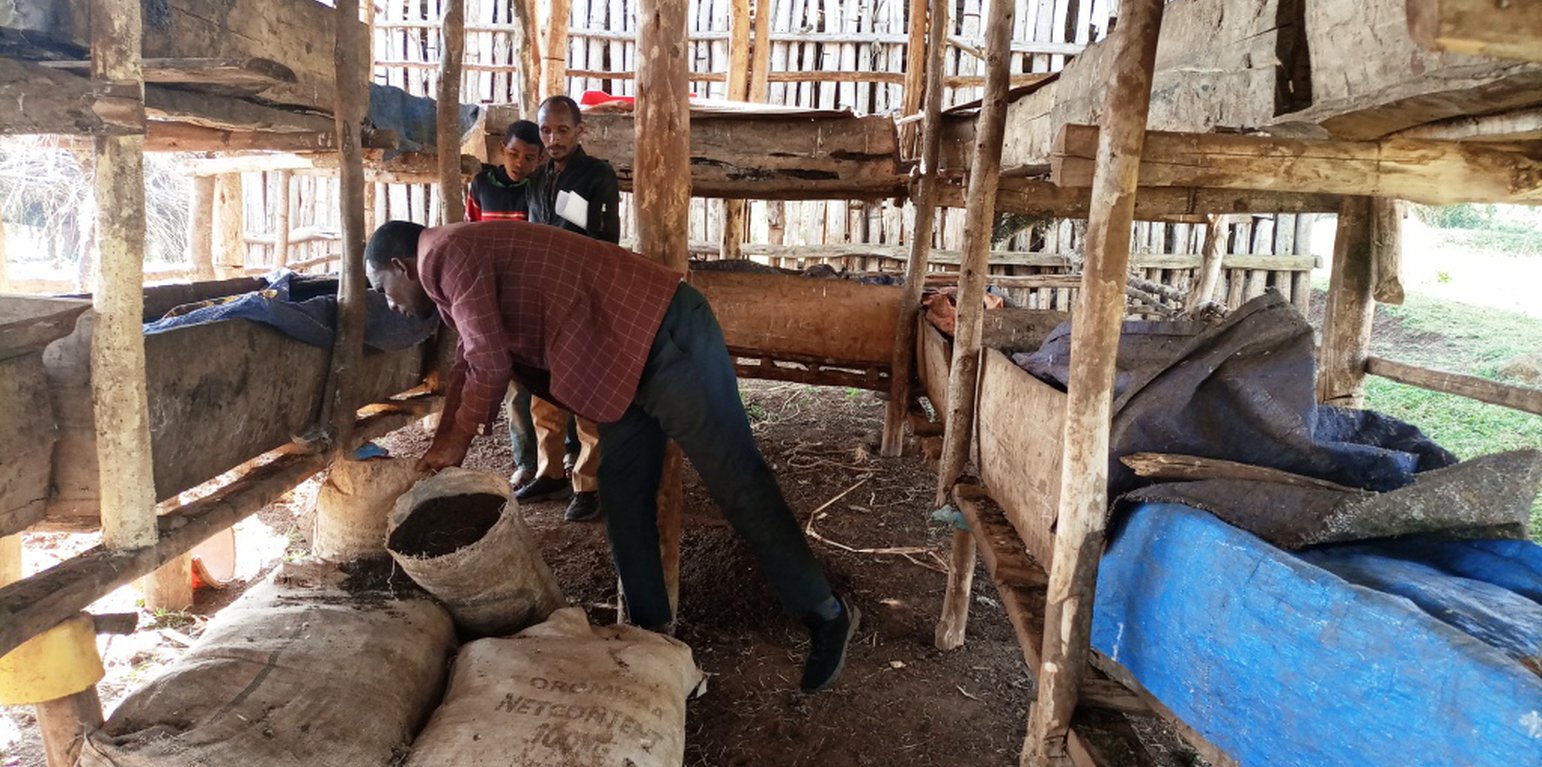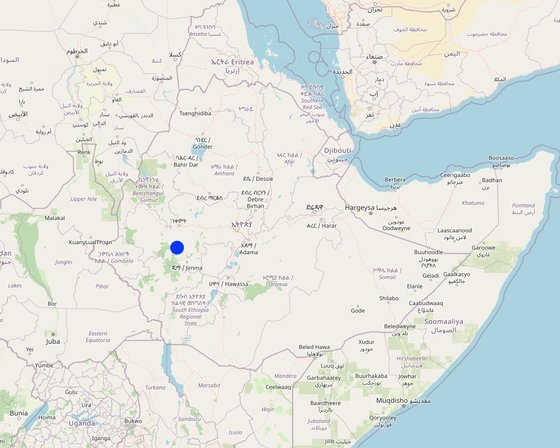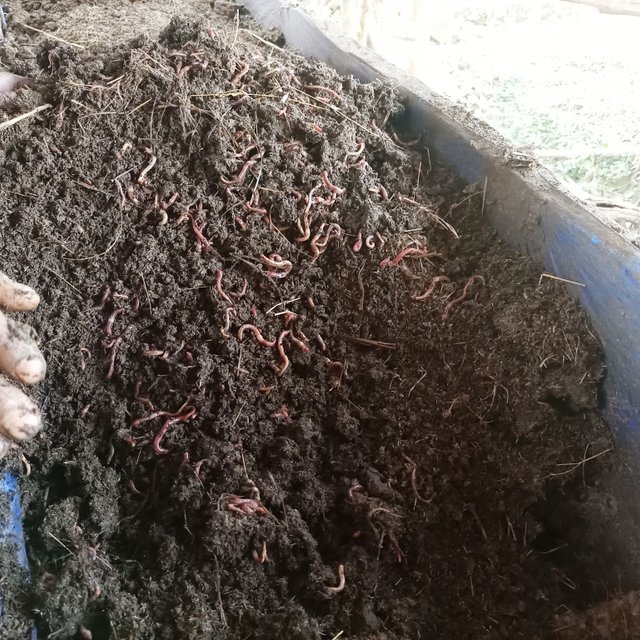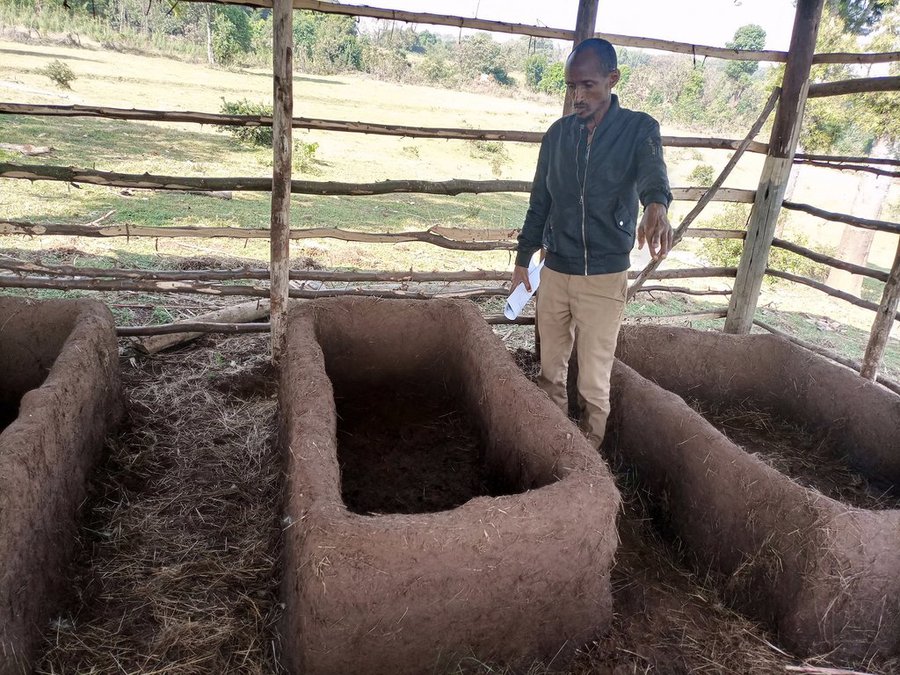



Vermicomposting is the process by which worms convert organic materials (usually wastes) into a humus-like material known as vermicompost. The process is an aerobic, bio-oxidation, non-thermophilic process of organic decomposition that depends upon earthworms to fragment, mix and promote microbial activity. In making vermicompost, earthworms are very good at transforming dead plant material, and livestock droppings into excellent manure. The excrement of the worms has high nutrient levels and a growth‐promoting effect on plants. Earthworms are very sensitive to changes in moisture and temperature. They need a continuous food supply and protection from ants, birds, and chickens. Compared to ordinary compost making, it needs maximum care. For optimum management practices, vermicompost production must be located close to the homestead where livestock barns are usually located. Livestock droppings (especially those of horses and donkeys) are the best sources of feed in addition to plant biomass and other household refuses. Vermicompost production needs a bin in which the worms live. This holds the bedding and food scraps, regulates the amount of moisture and temperature in the bedding, and blocks light which is harmful to the nocturnal worms. Worm bins can be made from plastic or wooden materials. In Ethiopia, wooden boxes are preferred because they are more absorbent and provide better insulation.
Vermicompost reduces farmers’ investment costs on chemical fertilizers. It also has a sustainable role in restoring soil fertility, ameliorating soil acidity and rehabilitating degraded farmland – all of which are problems in the southwestern part of Ethiopia. In the farm where vermicompost is applied, newly transplanted seedlings, in the case of vegetables, remain green and resilient as the compost improves not only the nutrients but also the moisture content of the soil. According to the land users, annual and perennial crops such as horse beans (Vicia faba), wheat, cabbages and avocados grown under vermicompost do very well. Under ideal conditions, 1,000 earthworms can convert 45kg of wet biomass per week into about 25kg of vermicompost. Therefore, the size of production depends on the number of worms, supply of foods, availability of boxes, and associated management practices. In rows and spot application of vermicompost during planting the crop allows efficient and effective uses of the products.
Currently (2023) the government in the southwestern zones of Oromia Region is promoting vermicompost as a vital organic fertilizer. This signals a change in the public sector's and end-users’ mindset in the use of organic fertilizer as a reliable soil amendment, particularly in acid-prone areas. In general, compost restores soil fertility, increases crop production and improves the livelihood of the end users. While the initial cost of constructing the house and installing bins and worms is high, there is potential for the use of local materials. However, it demands considerable household labour for upkeep.

地点: Gechi district, Oromia, Buno-Bedele Zone, 埃塞俄比亚
分析的技术场所数量: 单一场所
技术传播: 适用于特定场所/集中在较小区域
在永久保护区?: 否
实施日期: 2020; 不到10年前(最近)
介绍类型








| 对投入进行具体说明 | 单位 | 数量 | 单位成本 (ETB) | 每项投入的总成本 (ETB) | 土地使用者承担的成本% |
| 劳动力 | |||||
| Labor | PDs | 183.0 | 200.0 | 36600.0 | 100.0 |
| 设备 | |||||
| Boxes | number | 14.0 | 250.0 | 3500.0 | 100.0 |
| 其它 | |||||
| House with corrugated iron sheet | Lump sum | 1.0 | 25000.0 | 25000.0 | 100.0 |
| Worms | kg | 12.0 | 500.0 | 6000.0 | |
| 技术建立所需总成本 | 71'100.0 | ||||
| 技术建立总成本,美元 | 1'338.48 | ||||
| 对投入进行具体说明 | 单位 | 数量 | 单位成本 (ETB) | 每项投入的总成本 (ETB) | 土地使用者承担的成本% |
| 劳动力 | |||||
| Labor for follow-up and related practices | PDs | 183.0 | 200.0 | 36600.0 | 100.0 |
| 技术维护所需总成本 | 36'600.0 | ||||
| 技术维护总成本,美元 | 689.01 | ||||
SLM之前的数量: Abandoned for faba beans
SLM之后的数量: 1.2 tons/ha
The yield of Faba bean increased from negligible yield where a farmer abandoned it to over 1 ton per hectare.
It was not scientifically measured but the farmer communicated the harvest of good seed size with better tastes as compared to the harvest without using vermicompost.
There is an assumption and evidence that validate that compost favors the growth of diverse wild species. Also, it increases biomass production that associates with fodder or feed production.
The use of vermicompost enables to regain of the lost crop species because of soil degradation.
As it added organic matter to the soil, it improves soil structure and other attributes of the soil that improve the land.
It reduces investment on synthetic fertilizers and allows to harvest organic products.
As most of the distinctions between the treatments with SLM technology vs without technology are not properly documented by the land users, it is difficult to quantify them. However, the evidence from the demonstration plots shows the yield increments by more than quadruple per unit of land. Since then the technology is applied recently, and promoting documentation of the yield difference by the land users themselves is commendable to ensure access to reliable data.
Generally, it added value to the efforts of ensuring food as well as nutrition security.
Health situation is converging with ensured food and nutrition security.
Increased through exchange visit and participatory learning of the effect of the technology on the farm.
Slightly improved with access and use of the technology.
This is with the assumption that vermicompost improve soil structure via the addition of organic matter and improves water infiltration than favoring runoff.